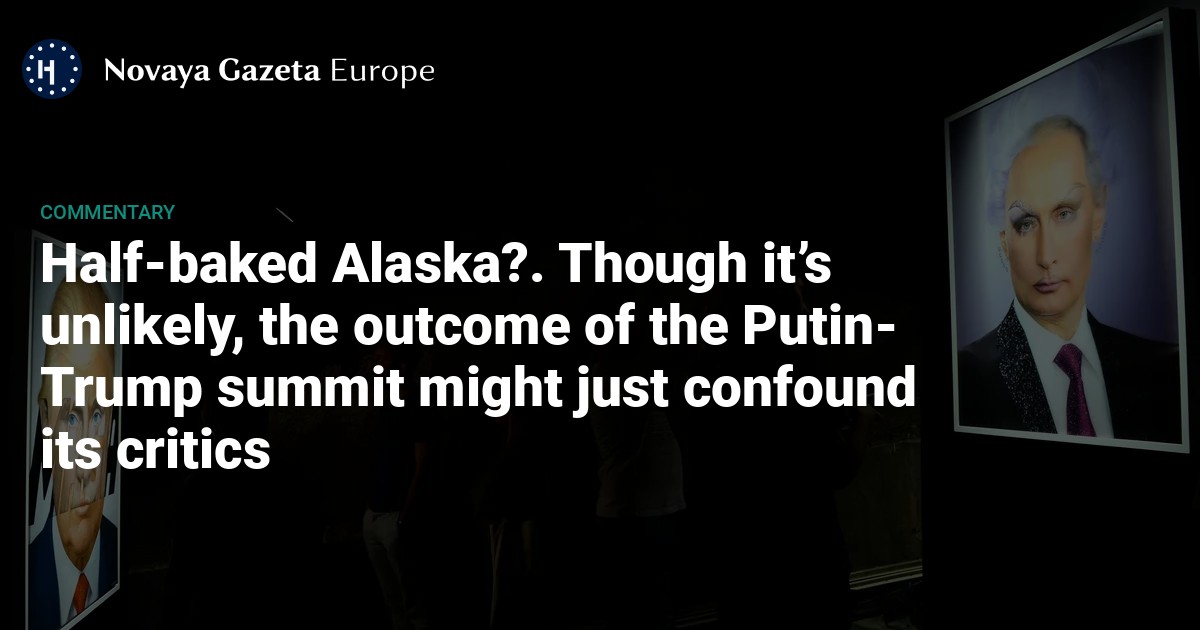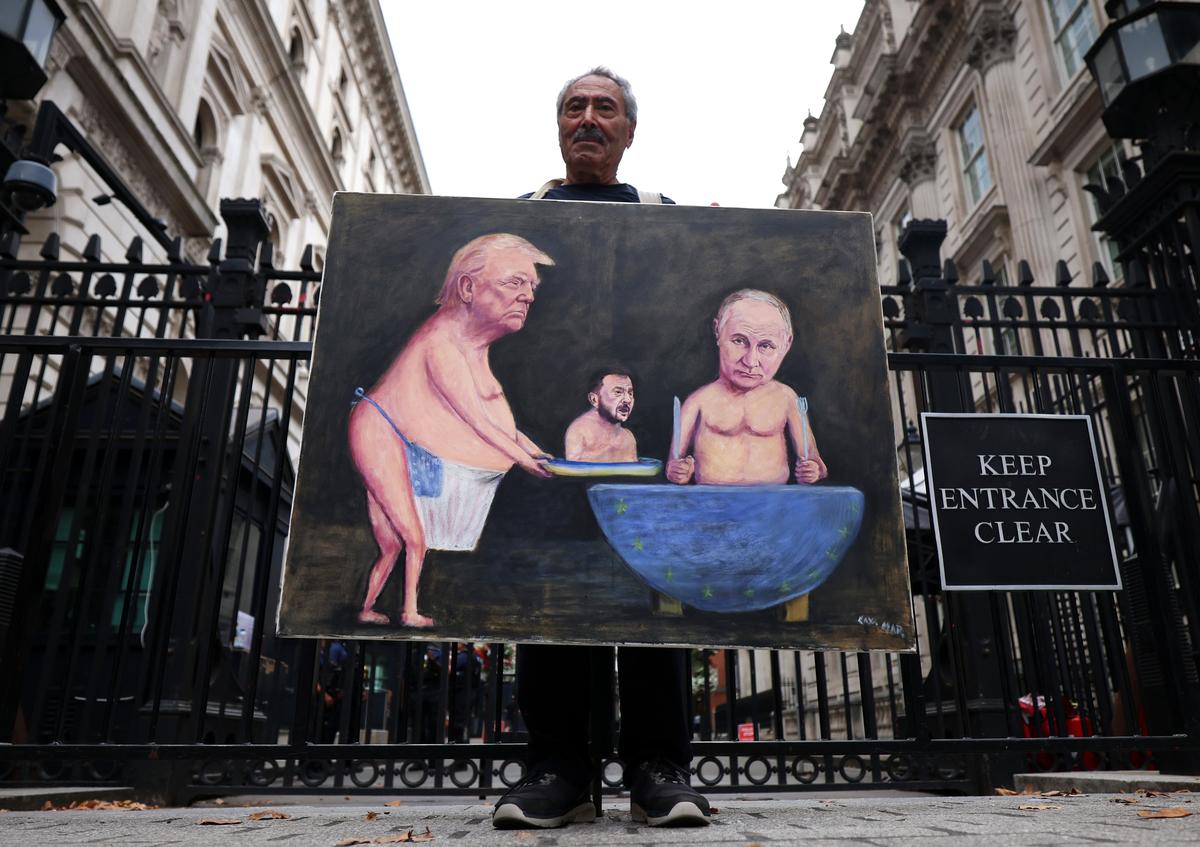



Like many such confabs before it, the Alaska red carpet rollout for Vladimir Putin is classic Donald Trump: a show of diplomacy as pageantry that seemingly came out of nowhere, replete with vague goals and hardened expectations about the outcome from Trump supporters and opponents alike before the event has even taken place.

Peter Rutland
Professor of Government, Wesleyan University, Connecticut
Trump is seemingly trying to dial down expectations, billing the summit as a “feel-out meeting” with the Russian leader to try to reach a diplomatic solution to the more than three-year-old Russian war in Ukraine.
The event follows a recent period where Trump had become more critical of Putin’s role in continuing the war, giving the Russian leader a 50-day deadline to end it or else face new US sanctions. Trump subsequently reversed course on military support for Ukraine and stepped up weapons shipments. However, he has always made it clear that his priority is to restore a good relationship with Russia, rather than save Ukraine from defeat.
Trump’s track record of admiration for Putin, and the summit format that excludes both Ukraine and its European allies, has provided ample fodder for critics of US policy under Trump.
Military scholar Lawrence Freedman expressed a common critical refrain in expressing fears that Trump will concede to Putin’s core demands in Ukraine in return for a ceasefire. Likewise, CNN’s international security editor Nick Paton Walsh, said it was “hard to see how a deal emerges from the bilateral that does not eviscerate Ukraine.” Indeed, few mainstream establishment commentators in the US or European capitals are supporting Trump’s initiative, though Anatole Lieven, at the anti-interventionist Quincy Institute, was one of the few giving at least a lukewarm endorsement.
Meanwhile, in Moscow, despite Trump’s vague talk of a “land swap” that implies Ukraine could regain some lost territory, the uniformly pro-government Russian press is already hailing the upcoming summit as a victory for Putin and “a catastrophe for Kyiv” as the tabloid Moskovsky Komsomolets declared.
Still, as a long-time observer of Russian politics, I believe it would be premature to write off the summit as an exercise doomed to fail. Respected Russian émigré journalist Tatiana Stanovaya, for one, has argued that the meeting offers the “first more or less real attempt to stop the war”, and there are several important developments that mainstream commentary has overlooked in arguing against prospects for the Alaska summit.
Seven months into his second term, Trump appears flush with confidence and has shown more willingness to project power to advance American interests.
Despite Trump’s repeated pledge to end the war in Ukraine, there has been no progress to that end thus far. Trump’s earlier efforts to broker a ceasefire, in February and April, were both rebuffed by Putin. However, since then, a number of factors have shifted that could allow Trump some leverage in talks this time around.
Seven months into his second term, Trump appears flush with confidence and has shown more willingness to project power to advance American interests. In June, he joined Israel’s airstrikes against Iran, Russia’s biggest ally in the Middle East, and last week, he hosted the leaders of Armenia and Azerbaijan at the White House to sign a historic peace deal — a huge diplomatic defeat for Russia, which historically has dominated the politics of the South Caucasus.
Trump’s ongoing global trade war is also alarming for Russia. On 7 August, Trump slapped punitive new tariffs on 90 countries that failed to make deals before his deadline. Trump has shown himself willing to use American power to bully trade partners who cannot effectively retaliate — such as Brazil, Canada, Switzerland and now India.

Political satirist Kaya Mar holds his picture of Donald Trump serving Ukrainian President Volodymyr Zelensky up to Putin on a plate outside Downing Street in London, 13 August 2025. Photo: EPA / ANDY RAIN
Indeed, Trump noticed that India bought US$80 billion of Russian oil last year — more than China. On 6 August, the same day that Trump announced the Alaska meeting, he imposed 50% tariffs on India, which will not come into effect for 21 days unless India cuts back on imports of Russian crude.
That creates real leverage for Trump against Putin should he want to use it in Alaska. With the Russian economy under strain and with global oil prices falling, Russia risks losing critical revenue from selling oil to India. That could conceivably be the tipping point for Putin, persuading him to halt the war.
As significant as those shifts could be, there are still several grounds for scepticism. India may ignore Trump’s oil sanction. Key Indian exports to the US, such as iPhones and pharmaceuticals, are exempt from the 50% tariff, and they account for about $20 billion of India’s $80 billion annual exports to the US.
Moreover, the global oil market is highly adaptable. Russian oil not bought by India could easily be picked up by China, Turkey, Italy, Malaysia and others. Even if Russia lost $10 billion to $20 billion as a result of the India sanctions, with overall government revenue of $415 billion a year, that would not derail Moscow’s ability to wage war on Ukraine.
It remains unclear what Trump actually hopes to achieve in Alaska. The details of the deal he is trying to persuade Putin to accept are unclear. For the Trump administration, the basic idea for ending the conflict appears to be land for peace: an end to military action by both sides and de facto recognition of the Ukrainian territory currently occupied by Russian forces.
One glaring problem with this formulation is that Russia does not control all the territory of the four Ukrainian provinces that it claims. They occupy nearly all of Luhansk, but not all of Donetsk, and only 60% of Zaporizhzhia and Kherson. If Russia insists on taking all of Donetsk province, for example, Ukraine would have to hand over about 6,500 square kilometers, with 200,000 people, mainly in the cities of Kramatorsk and Slovyansk. It is hard to imagine Ukrainian President Volodymyr Zelensky agreeing to such a concession.
Yet it is equally hard to see Putin giving up his claim to all four provinces, which Moscow unilaterally incorporated into the Russian Federation in September 2022. In a speech he made to the Russian Foreign Ministry in June 2024, Putin laid out his most thorough analysis of the “root causes” and course of the war in Ukraine to date. He stated that the legal status of the four provinces as part of Russia “is closed forever and is no longer a matter for discussion.”
Both Ukrainian and Russian societies are tired of a conflict that neither of them wanted. But at the same time, in neither country does most of the public want peace at any price.
Clearly, the territorial question is the biggest hurdle facing any would-be peacemaker, including Trump. Other issues, such as Ukraine’s request for security guarantees, or Russia’s demands for the “denazification” and “demilitarisation” of Ukraine, could be dealt with later through negotiation and third-party mediation.
There are other factors that play into the chances of peace now, however. Both Ukrainian and Russian societies are tired of a conflict that neither of them wanted. But at the same time, in neither country does most of the public want peace at any price.
If Trump can persuade Putin to agree to give up his claims to the entire territory of the four provinces in Ukraine’s east, that would be a substantial concession — and one that Zelensky may be well-advised to pocket. Putin would also expect something in return, such as the lifting of international sanctions and restoration of full diplomatic relations with the US. Then Putin could fly back to Moscow and tell the Russian people that Russia had won the war.
If such a deal transpires in Alaska, Trump would then face the challenge of persuading Ukraine and Europeans to accept it. However, given Putin’s apparent confidence that Russia is winning the war, it remains unlikely that he will be persuaded by anything that Trump has to offer in Anchorage.
This article was first published by The Conversation. Views expressed in opinion pieces do not necessarily reflect the position of Novaya Gazeta Europe
The Russian government has banned independent media. We were forced to leave our country in order to keep doing our job, telling our readers about what is going on Russia, Ukraine and Europe.
We will continue fighting against warfare and dictatorship. We believe that freedom of speech is the most efficient antidote against tyranny. Support us financially to help us fight for peace and freedom.
By clicking the Support button, you agree to the processing of your personal data.
To cancel a regular donation, please write to [email protected]
VPNovaya
Help Russians and Belarusians Access the Truth
